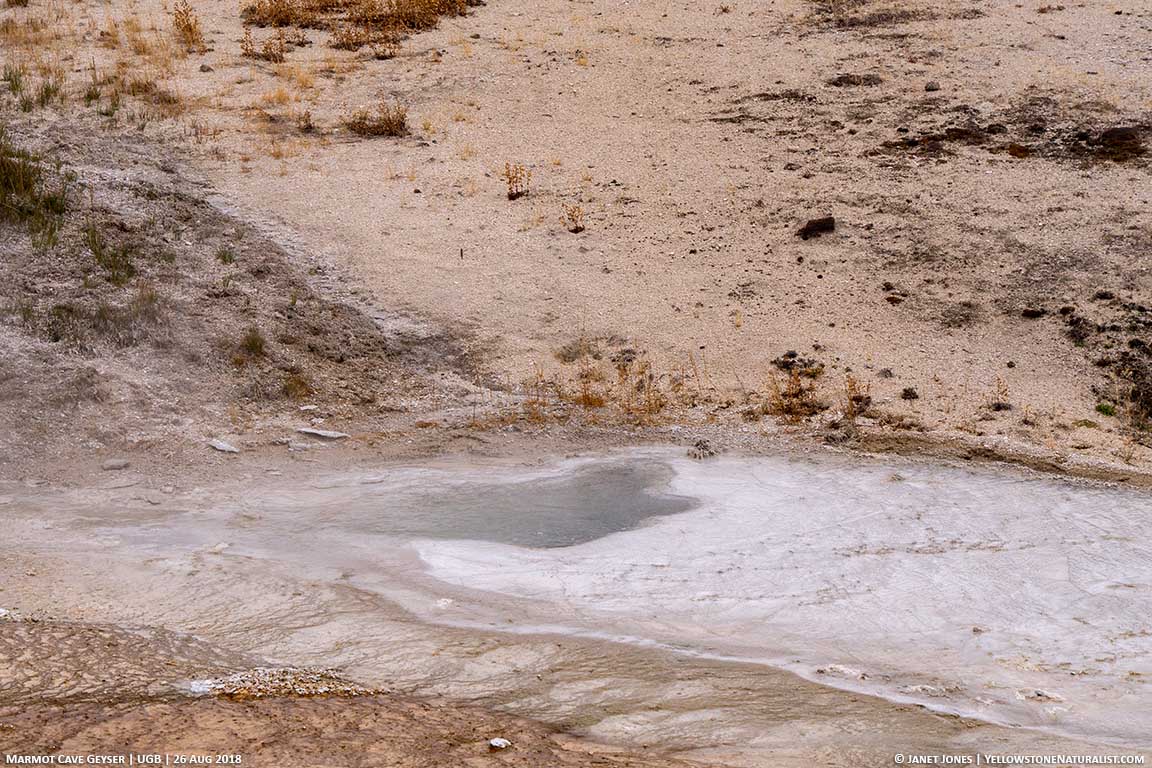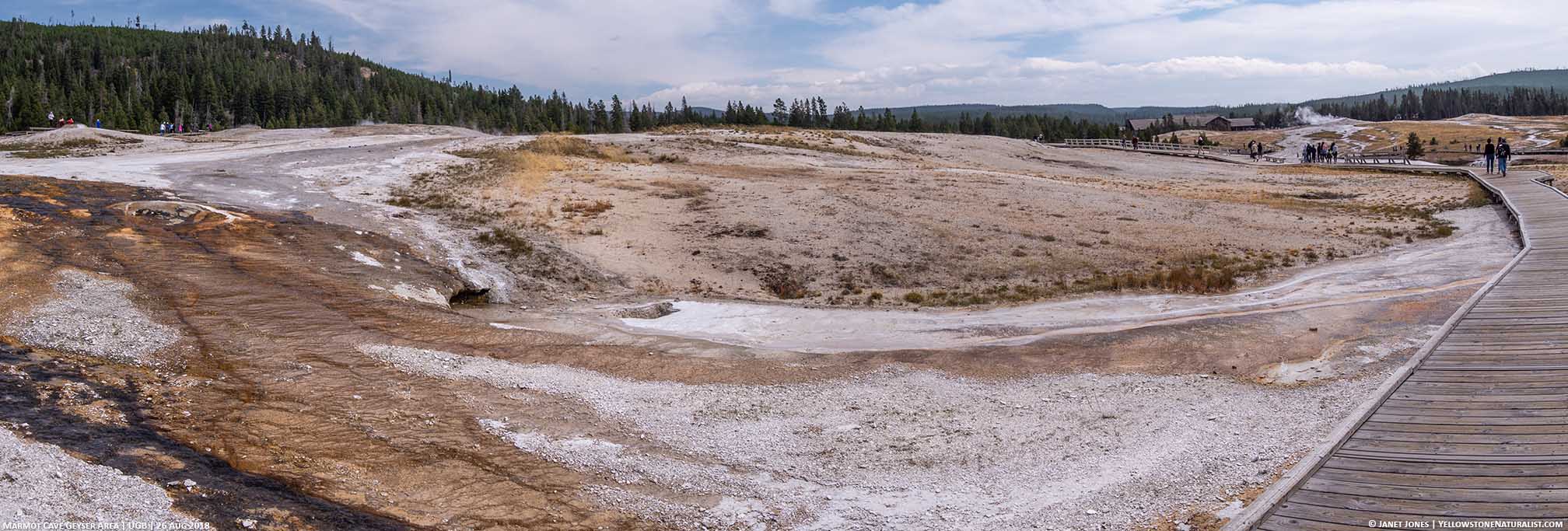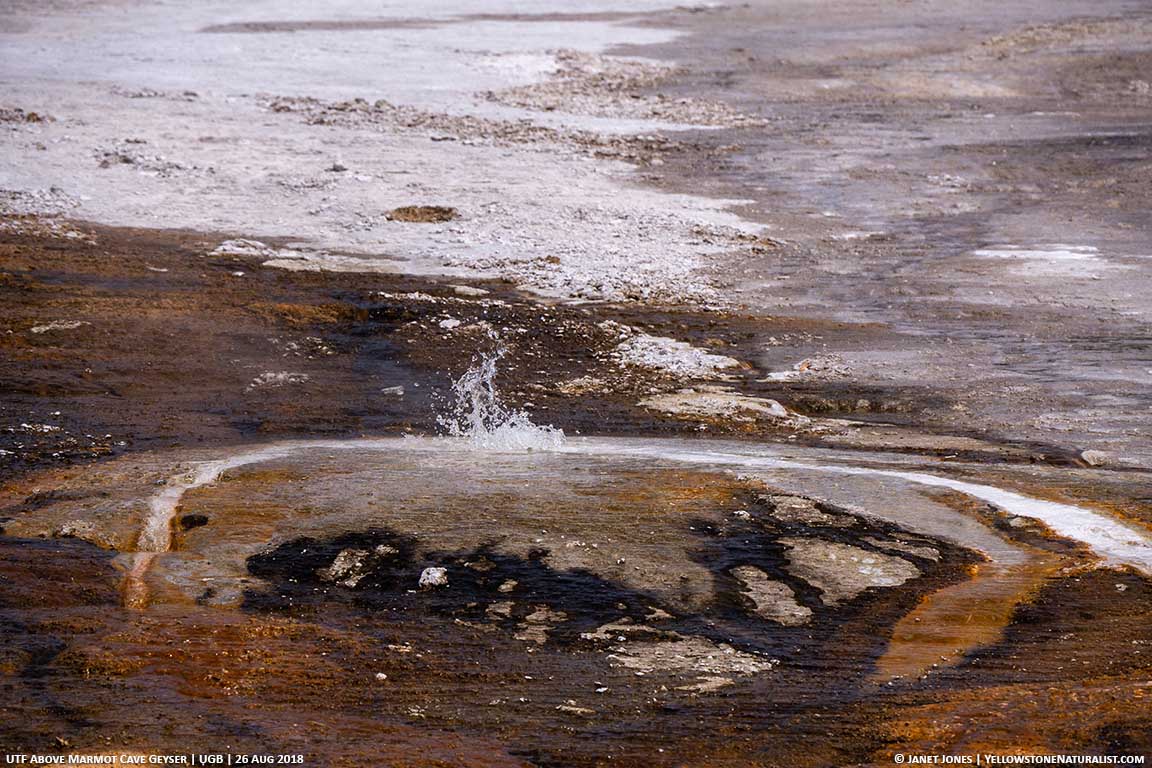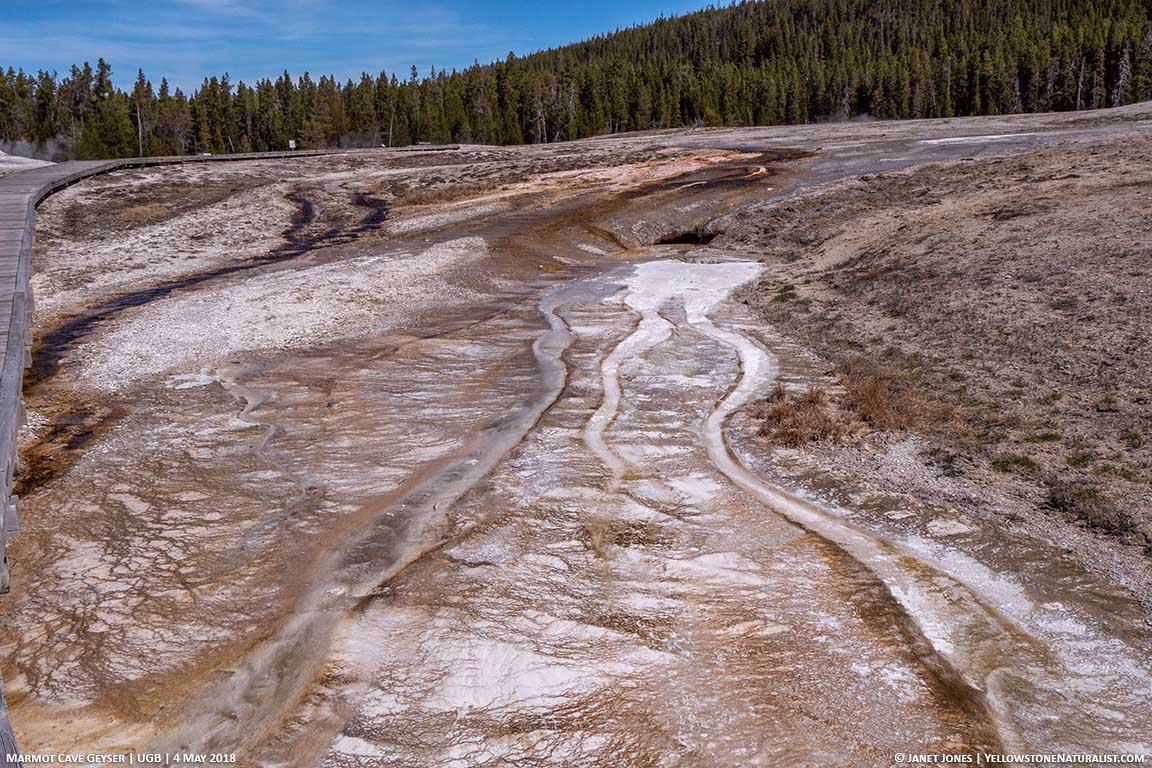Observations of Marmot Cave Geyser | Aug 2018
On days in Yellowstone, I often will pick a thermal feature to sit by and observe for a short time. It helps to have a question to answer, and when I learned that Marmot Cave Geyser was seen in eruption on 7 Aug 2018, I wondered what the cycles seemed to be and to hope for an eruption.
This post contains affiliate links. That means that if you click on the link and follow it and purchase an item, I will receive a small portion of the proceeds at no extra cost to you.
When first observing activity, I don’t filter what to look for so much as just write it all down and sort it out later. With the geysers I need to listen as much as I watch because the sounds of water can give clues as well. I’m still waiting for my printer to arrive so I can actually enter this into the Upper Geyser Basin “species accounts” page in my physical field journal.
ABOUT MARMOT CAVE GEYSER
Marmot Cave Geyser is a smaller thermal feature is located not far from Beehive Geyser. It’s actually across the boardwalk from Arrowhead Spring.
Behind the actual geyser is a cave of sorts. The water from a hot spring just above this area flows over the roof of the cave as a small waterfall. The silica rich water is always leaving a bit of that silica behind and washes any loose rocks in the overflow channel. This results in the slow filling in of this cave. In years past, when the cave was larger, a Yellow-bellied Marmot lived there, giving the geyser its name.
Marmot Cave Geyser has not been reported in eruption for decades. However, over the past couple of years, it fills, pulses some and then drains. So now I’m curious as to what we can learn. Because of Geyser Times, there’s a good way of sharing smaller observations. I will tear this overall observation apart and enter in the basics there. However, there is value in keeping the entire observation together as a whole because I not only observed the behavior in Marmot Cave, but its neighbors as well: “The Mouth,” The UTF (Unnamed Thermal Feature) Above Marmot Cave Geyser, and overflow from Dragon Spring (that hot spring that overflows over the cave entrance).
Eruption heights were not entered into Geyser Times (yet), but I have heard reports of 3 feet and 6 feet (1-2 meters). I still look forward to catching my first eruption of this rarely active geyser.
I did use abbreviations in my field notes, but wrote those in there. You think you’ll remember what that abbreviation meant, but that’s not always the case (ask me how I know). I also include random thoughts that come to me as I observe. So much of “science” makes you think you need to be 100% accurate from the start. Not so! Not knowing is how you learn, how discoveries are made, and where the fun in all of this really lies. Could I come to some incorrect conclusions? Absolutely. That’s one of the reasons I want to put this out there – I welcome your thoughts whether they agree with mine or not. This is what pushes our overall understanding. To do this “open science” means not needing to be right, but seeking the value of everyone’s input. It’s about always being a beginner.
The times here are noted as a 24 hour clock without using a colon between hours and minutes for ease of transcription.
OBSERVATIONS
MC = Marmot Cave Geyser
M = “The Mouth”
AMC = UTF Above Marmot Cave Geyser
DO = Dragon Geyser’s overflow over the cave’s entrance
1345 – Arrived at Marmot Cave Geyser (referred to as MC). It was empty of water and steaming. The Mouth (referred to as M) was on. The small unnamed bubbler Above Marmot Cave (referred to as AMC) was off.
1354 – AMC on for a few seconds
1355 – AMC spit once
1356 – AMC showed steadier spitting for less than a minute.
1357 – MC fast fill to overflow and began to pulse.
1359 – Increased overflow from Dragon Spring (the spring above that overflows over the actual “marmot cave”). AMC on. Bubbles in MC and then the water drained out of sight. M splashing stopped and the water level pulsed at the level of the rim. After MC drained, the overflow from Dragon Spring slowed as well.
1400 – M restart of splashing. AMC on strong – the tallest splashes reached 6-8″.
1405 – Slowing in splashes from M.
1406 – Overflow from Dragon Spring is down to a trickle.
1408 – AMC paused, and then began spitting about every second – I wouldn’t really classify it as splashing.
1415 – Rise in water in MC – slower fill this time. Pulsing as it rose to overflow.
1418 – MC drain. M paused, drained, refilled and then drained again. AMC paused.
1419 – AMC restart. M remained empty. No extra overflow from Dragon on this cycle (maybe a coincidence?)
1420 – AMC off – Is this a system drain?
1421 – M start. AMC spitting occasionally.
1425 – Increased overflow from Dragon. Just realized there are no microbes in Dragons runoff channel. Need to check photos to see what it looked like earlier this summer.
1426 – Spitting in AMC.
1428 – AMC quiet and Dragon’s overflow down to a trickle.
1431 – AMC spitting
1434 – AMC more constant spitting
1435 – Fast fill to overflow in MC
1437 – Strongest pulses from MC seen at the end right before draining. M paused with the water pulsing at the rim top. AMC gurgling. No change in overflow from Dragon.
1438 – M start
Left the area – getting out of the wind!
TAKEAWAYS
Closed Intervals
This time in the wind on Geyser Hill gave me two closed intervals. This means the intervals between eruptions (or in this case, overflow and opportunities for eruptions) were observed continuously and no other eruptions (or opportunities for eruptions) occurred.
1357-1415 gave a closed interval of 18 minutes.
1415-1435 gave a closed interval of 15 minutes.
Looking at Geyser Times, I see on 7 Aug 2018 under Notes, the closed intervals were quite a bit shorter at 10-13 minutes. This makes me wonder if that’s a clue as to a lead up to an eruption – do they shorten? I only have two data points (and need many more), but could those cycles shorten as they lead up to an eruption? So, looking more at the valuable notes on Geyser Times, I see the 10-13 minute intervals were about an hour before the eruptions. And the closed intervals between eruptions were down to 9-11 minutes and then slowed to 22 minutes. So is this geyser erupting in a series? Possibly.
Connections
By observing more than just the one thermal feature, perhaps this will give clues as to any connections that might exist.
The UTF Above Marmot Cave has been occasionally active in the past as far as my memory can recall. But I’ve not seen it consistently active as it seems to be this year. There are also many small bubblers like this in the vicinity, so my memory is not necessarily accurate on this. For that reason, I’m taking photos to document this location. This one may be connected, but more time spent observing here with detailed notes would be needed. The behavior observed for this short time didn’t lend itself to an easily seen connection.
“The Mouth” showed a consistency in a pause in splashing each time I saw Marmot Cave Geyser drain. I’ve also noticed this on a couple random walk-by observations. So, this has a bit more credibility as a possible connection as far as I can tell.
Dragon Geyser’s Overflow channel seems much larger than in past photos. At 1425 while keeping my eye on Marmot Cave Geyser, I heard a sudden increase in overflow from Dragon Geyser. While I wasn’t really watching that deliberately before that time, this increase told me that I might as well watch for that while here. Since I only saw/heard this sudden increase one time, I’m very doubtful that there’s a direct connection. Despite this thought, I will continue to take notes on increases in overflow simply to pull more information from observations – fully expecting it to be isolated observations for Dragon Geyser (not a bad thing to do).



